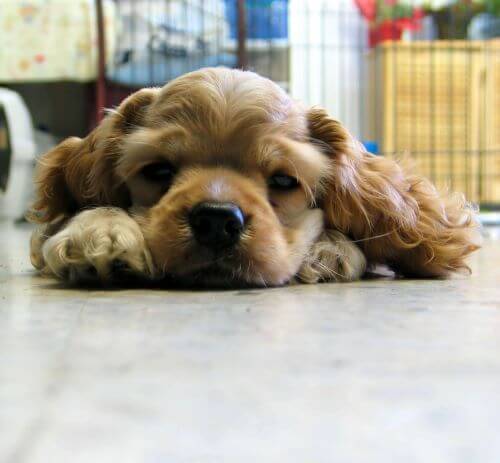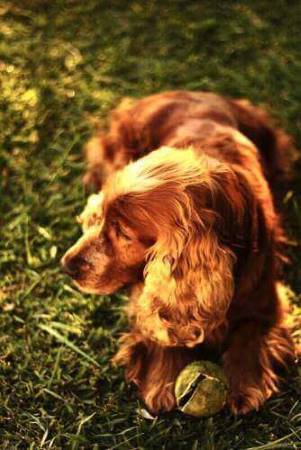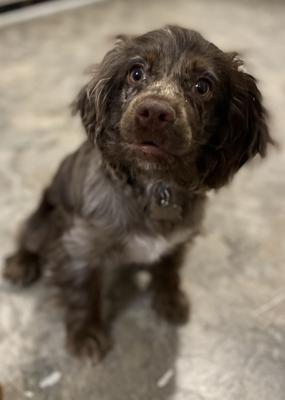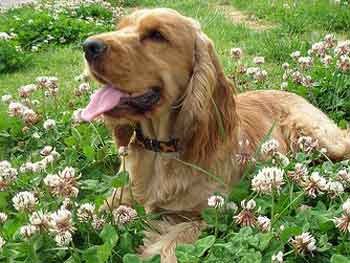- Home
- Cocker Spaniel training
- Crate training a dog
Crate Training A Dog
Is crate training a dog going to be difficult? Not necessarily, but you'll have to begin from scratch and he may be a little harder to crate train than a puppy. It's certainly not impossible, and you can learn how here.
Who said you can’t teach an old dog new tricks?
Crate Training A Dog - Start Over
The success to crate training a dog is not to rush - take it slowly!
If your Cocker Spaniel has never been in a crate before, it's probably best if you begin his training from scratch.
The same will apply if he's had any previous unhappy or frightening experiences in a dog crate. You will have your work cut out for you in making him see his crate as his 'happy place'.
Depending on the circumstances, (he's been re-homed, he was a rescue dog, unpleasant memories of a crate) crate training could take up to 3 weeks.
 Crate training a dog is easy when you know how to!
Crate training a dog is easy when you know how to!Don't rush your dog, allow him plenty of time to get used to his new cage. Take one step at a time, and move on only when you feel he's ready.
The instructions for dog crate training are very similar to those for crate training a puppy, and before I begin to explain further, you might want to read read the essential rules of crate training to give you a bit of background information and an idea of how to approach it.
Dog Crate Training: A Room With A View!
Decide where you're going to place your dog's new 'den'.
In my opinion, the best place would be in an area where he can see what's going on, but not so noisy that it would disturb him if he's sleeping.
An ideal place would be in a quiet corner of the room, away from any draughts, and because it's in a corner, it will make your Cocker's space feel cosy and den-like.
If you don't have a spare corner, the next best thing would be to drape a towel over the top of the crate, leaving the entrance open.
Place one of his 'fragrantly scented' blankets into the bottom of the crate to help make it feel more comfortable and smell more like 'home', throw in his favourite toy and a couple of training treats and leave him to if for a while.
With a bit of luck, this may be enough to tempt him to go inside!
Crate Training A Dog
Step 1: Going In And Out!
After a few days of wandering past and/or sniffing his crate, and he's still not going inside, it's now time to begin the training.
Tempting Your Dog Into His Crate
- Ask your pet to sit by his new home.
He may automatically step inside; if he does, praise him and give him a treat - it's looking good!
If he appears wary, place a treat on the floor at the entrance and another just inside to tempt him in.
 Just dozing...!
Just dozing...!When you're adult dog crate training, your main objective is to help your Cocker Spaniel to recognize that good things happen to him when he's in or around his crate and that he has nothing to be afraid of.
- Next, throw a couple of treats into the back of his crate so that he must step inside to reach them. If he goes inside, praise him.
Don't close the door at this stage otherwise you may startle him.
Practice this a few times until your Cocker seems comfortable with going in and out of his cage.
- At your next training session, place some treats into his cage to tempt him back inside and as he's finishing his last treat, call him to you. As he comes out, praise him and give him a small treat and lots of cuddles.
(He was probably going to come out at that point anyway, but this way your Cocker is responding to your command, ie. doing things on your terms, not his.)
Drop The Treats: Reward Your Dog With Praise Instead
After trying this exercise a couple of times, begin rewarding your dog with praise only for coming out of his crate when asked; don't reward him with treats.
Treats should now be reserved only for going inside his crate.
If your Spaniel leaves his crate without being asked, don't praise him.
Because your pet is older, he's probably been trained so he will understand the basic puppy obedience training commands such as sit, down, stand, etc.
These commands can be very useful at this stage of his training.
Crate Training A Dog
Step 2: Entering His Crate on Command
When your pooch is happily entering and leaving his crate, begin using the words "into bed" (or whatever words you prefer) just as he's stepping into it.
As with most dog training, timing is crucial. Voice the new command just as he's stepping inside to help him associate the command words "into bed" with going into his crate.
After a few training sessions where you've used your new command, if you haven't already done so, drop the use of treats.
 What a beautiful Cocker Spaniel!
What a beautiful Cocker Spaniel!You now want your Cocker Spaniel to enter his cage because you've asked him to, not because he's been 'bribed' with a treat!
If he doesn't do as you've asked, just wait until he eventually goes inside. When he does, praise him enthusiastically to let him know that he did exactly what you wanted him to do.
If he doesn't make a move, simply end the training session and try again later.
Never try to force your Cocker Spaniel to go into his crate.
When you're crate training a dog, you will need to have a lot of patience, so take things slowly!
Repeat the above sessions a couple of times each day and your pooch will soon be trotting in and out of his cage on command.
Crate Training Your Dog
Step 3: Closing The Crate Door
Your next exercise in crate training a dog involves closing the door for a few seconds while your Cocker is inside.
Scatter several small treats or a favourite toy into the crate, preferably at the back, and give your pet the command to go inside.
As he does so, close the door behind him.
The treats will keep him occupied for a few moments. As soon as he picks up his final treat he may turn around and move to leave. If this happens, open the door.
Don't forget, you should no longer be rewarding your Cocker for going in or leaving his crate. However, if he comes out and you didn't ask him to come out, don't praise him.
 Rub my tummy Mummy!
Rub my tummy Mummy!After practicing
closing and opening the door a few more times, repeat the exercise
but this time leave the door closed for 30 seconds after he
finishes the last treat.
He may paw at the door or whine to be let out. If he does, feed him a treat through the bars to settle him down before opening the door.
If you let him out when he's still whining, or pawing at the door, he will learn that he doesn't need to stay inside his crate and that all he needs to do is whine, or paw at the bars, and you will let him out.
Practice the above until you can leave your Cocker locked inside his crate for a few minutes and then gradually build on this until he can tolerate being locked inside for longer periods.
Feed Him In His Crate
To help get him used to being in his crate for longer, you might like to try feeding your Cocker inside his crate. If he knows he's about to be fed, it will definitely entice him to use it more often. You may even find him sitting inside it, waiting for his dinner!
Simply place his dish inside and leave him to it!
Once he's in, and eating, close the door behind him.
If he's hungry enough, he won't object, he'll simply eat his meal.
If you think he's uncomfortable and wants to be let out, allow him to come out but remember not to praise him. Leave his food in the crate, when he's hungry enough, he'll go back inside and eat it. Keep an eye on him so that when he does return you can close the door behind him.
This part of crate training a dog may take several attempts depending upon how comfortable your pet is with the door being closed.
Repeat the above at each mealtime but leave the door closed for longer each time. If he has a full stomach and he's comfortable, he may lie down and go to sleep. Now that would be a definite result!
Don't forget to offset any treats you give him against his daily food allowance, otherwise you may end up with a fat Cocker Spaniel and you certainly don't want that because overweight dogs are much more prone to health problems!
Crate Training A Dog
Step 4: Home Alone!
A well-behaved, fully house-trained pet won't really need to be locked inside his crate all day.
But until your dog is fully house-trained, or stops creating havoc when you're not around, it may be necessary to lock him inside his crate. Before you do this, it's important that your adult Cocker is used to, and comfortable with, being alone, locked inside his crate.
So we must teach him to relax and chill out in his crate.
Let's begin! Ask your Cocker Spaniel to get inside his crate and then close the door behind him.
Stay in the same room so that he can see you. Do a bit of ironing (yuk!), have a coffee or read a book, but let him see that you're still home. If you crate him while you're home, it will help to stop him linking being caged with being left alone.
 What now, Mum?
What now, Mum?If your pet is comfortable, (and not anxious) leave the room and return after 30 seconds.
If your dog stayed quiet and seems comfortable, praise him and carry on with what you were doing.
If you think it looks like he may want to get out, open the door before he begins to become unsettled or whines to be let out. If you can help it, don't set your Cocker Spaniel up to fail.
You may need to practice this part of his crate training many times during the day, gradually increasing the time you stay out of the room and he stays locked inside.
With practice (and patience) you will be able to leave your pet alone inside his crate for a few hours, if necessary.
TIP: If you crate your Cocker Spaniel after his morning walk, or after an extensive play-time, he's more likely to stay inside his crate and rest. Who knows, he may even fall asleep for a couple of hours - job done!
Crate Training A Dog
Step 5: Practice Some Basic Obedience Commands
You may like to try using some basic commands while you're crate training your dog and he's inside his cage.
Rewarding him with a treat after each successful command will not only reinforce the obedience commands but will teach him that his crate is a great place to be!
Try using the Stay' instruction when he's next inside his cage. Open the crate door and ask your Cocker to 'stay' for 30 seconds or so and then release him. If he stays as requested, reward him.
If he doesn't stay put, he's not ready to move on any further.
You may have moved on too quickly and will need to go back and repeat the previous crate training sessions. When you believe he's ready, you can try again.
Gradually increase the length of time you ask your pet to stay, but take it slowly because crate training a dog can take time and patience!
Crate Training A Dog Should Be Fun!
Crate training a dog should be a relaxed and fun affair. It shouldn't be stressful for either of you!
It's best to keep your voice light and fun sounding, and don't use low tones as he may think he's being reprimanded or punished.
One of the easiest ways of making crate training fun is to make it seem like a game; make it exciting for him.
You can do this by occasionally hiding a few small treats (or even yummy homemade dog biscuits!) inside his blanket at the bottom of the crate and let him sniff them out.
Placing his favourite toy in his crate or giving him a juicy bone to keep him occupied will make his crate a fun and interesting place to be.
Crate Training A Dog: Summary
I hope this article has given you enough information to help you with crate training your dog, that you've been successful, without too many hiccups!
I used a crate for Max when he was a puppy, and I still use it today but no longer lock him inside as he's fully house-trained and I trust him around the house.
If I need to leave him, I simply put him inside his cage (door open) but close the kitchen door and that's where he stays.
If he's over-excited when visitors arrive, he goes into his crate until visitors are settled, then he's allowed to come out to say hello.
He still occasionally uses it at night too, however, more often than not, he's on my bed!
If your dog isn't yet fully house-trained, you can learn how to potty training your dog here.
Photo credits for Crate Training A Dog:
1. Cynoclub at https://www.dreamstime.com/-image10324386
2. Nao at https://www.istockphoto.com/photo/puppy-gm92502956-536912/
3. Luis De Bethencourt at https://www.flickr.com/photos/luisbg/2149430216/
4. Copyright About Cocker Spaniels
5. Ronnie Meijer at https://www.flickr.com/photos/sweetron1982/4324144719/


